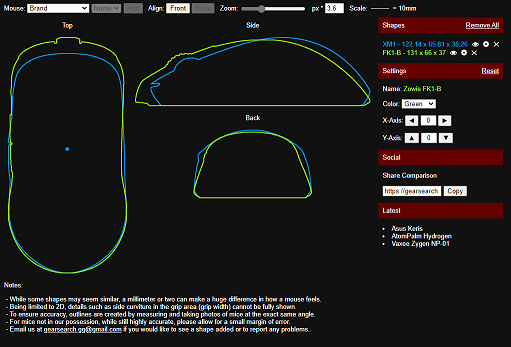Mice
There are a few basic considerations when choosing a mouse, it should be functional, comfortable and perform consistently.
In regards to functionality this generally refers to how many buttons there are and where are they situated or perhaps if it is wireless. For first person shooter (FPS) games you typically only need a couple buttons on either side of the mouse however when playing a real time strategy (RTS) game or massively multiplayer online (MMO) game you may need to bind actions to a large number of buttons or keys to work efficiently.
Comfortability relates to the shape and size of the mouse, is it ambidextrous, ergonomic, small, or large?


Recommendations
The following is a list of items to consider when searching for your ideal peripheral.
- The mouse should be approximately 65% the length of your hand, and has a center width that is roughly 75-80% the size of your palm.
- Measure the length of your hand in centimeters (cm) or milimeters (mm) starting from the base of your palm to the end of your index finder then measure the width of your palm.
- Mice may vary in size from the front to the back of the mouse, the back of the mouse is typically larger than the front.
- For the most natural click response ensure your fingers are directly above the mouse switch as indicated in the image above.
- To determine the location of the mouse switch find a review of the mouse which includes full teardown.
- Has manual calibration of Lift Off Distance (LOD), automatical calibration methods may not give the optimal result.
- See research on lift off distance calibration.
- Polling rate up to 1000hz (1ms) response time, use a polling rate of either 500 or 1000hz.
- If you have a lower frequency processor in the range of ~2-3ghz, 500hz may feel both more responsive and consistent.
- Select a mouse with the lowest click latency, compare the results and findings shared by reputable sources.
- Side buttons, if you have selected a mouse which is too large the side buttons may not align with your thumb, see graphic above for ideal placement.
- The mouse weight should be considerably light to the point where it may feel weightless providing a very natural response, ~60-80g.
- Mouse skates should be made of 100% PTFE or equivalent.
- You can purchase third party mouse skates made with different materials, if you have found a mouse that meets all other criteria see misc information for notes on mouse skate replacements.
- The mouse sensor should provide optimal tracking on a variety of surfaces, high accuracy and a high max tracking speed.
- Use the sites below to compare mouse shapes and see what might fit best, compare mice you currently own or have previously used along with the guidelines above.

Misc Information
- It always recommended to read both positive and negative reviews for mice to ensure there are no ongoing or known issues with the peripheral software, hardware or build quality in general.
- A higher dpi doesn't necessarily mean better, most FPS professionals play with 400 or 800 dpi with great results. On higher resolution settings there may be some modification to the input signal which could negatively impact the intended outcome of a mouse gesture. Also some games may exhibit strange behavior with higher dpi, it's best to see what feels and performs best for you in each game.
- Most people tend to lean towards optical mice versus laser mice, optical mice tend to give a more raw feeling where as laser feel like the movement is smoothed. Many laser sensors have been known to have inconsistent acceleration which can make it difficult to repeat gestures accurately.
- The mouse weight, mouse skates, mousepad and the lift off distance will significantly impact your perception of the mouses glide and response.
- If replacing mouse skates with a skate thicker than the factory default will increase the sensors distance to the tracking surface which may or may not negatively impact tracking, if that is the case then ensure the mouse provides a wide range of lift of distance calibration options to compensate.
- Keep an eye on vendor released firmware updates for bug fixes, if you don't notice any issues then it may not always be worth updating since firmware updates can be non-reversible.
- A mouse can only improve your game so much, the rest will come down to having a consistent end-to-end low latency system, consistent practice and development of your skills and techniques.
Popular Brands
- Zowie - https://zowie.benq.com/en-ca
- Finalmouse - https://finalmouse.com/
- Endgame Gear - https://www.endgamegear-shop.co.uk/
- Logitech - https://www.logitech.com/en-ca
- Razer - https://www.razer.com/ca-en
- Roccat - https://en.roccat.org/
- Steelseries - https://www.steelseries.com